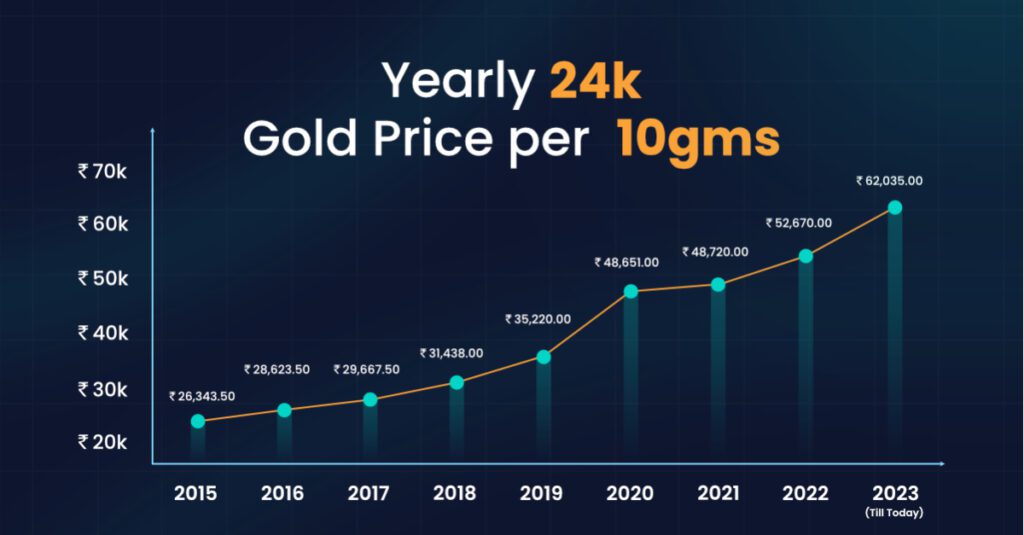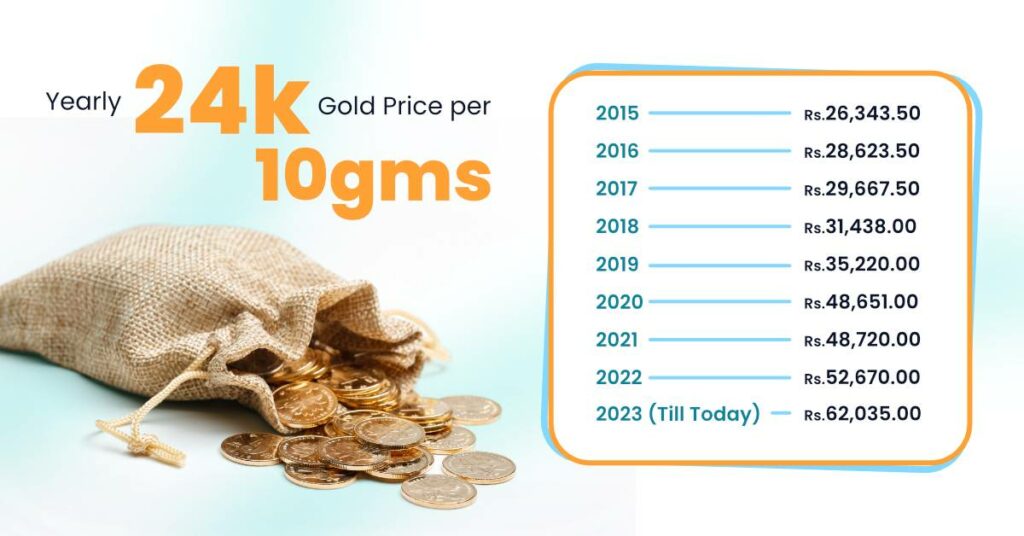Gold has been the underperformer of the recent decade, with a CAGR of 5.7% (in rupee terms) over the last ten years. In comparison, the Nifty has returned 15.5% over the last decade, while peer-to-peer investing has yielded up to 18% return on investment.
There was growth in gold in 2022, so it wasn’t a bad year. However, its value did not rise nearly as much as analysts and investors had hoped.
Predictions for 2023 are more optimistic, but keep in mind that they are only predictions.
The big question is whether Gold investment in 2023 is a good idea or not?
Experts believe investment demand will pick up in 2023 as investors are using gold investment as a safe haven amid rising recession fears. In Q322 of 2022, global central banks purchased more than 400 Tonnes of gold, the highest single quarter of demand in recent years. Given the current situation and recessionary fears, the central bank will continue to add gold to its reserves, according to the ICICI direct report.


Gold prices in India have changed in 2023. The price of gold has increased considerably since 2022. The yellow metal’s price grew by roughly Rs.3,000 in the first six months of the year, representing a gain of nearly 6.5%. The Russia-Ukraine war, US Fed rate hikes,US recession rumors and inflation have all contributed to rising gold prices. The rise in gold demand has caused the stock market to fall since the beginning of the year.
“Gold may finally get the recession it needs to shine in 2023. Gold has performed well in five of the seven US recessions since 1973. According to World Gold Council research, yellow metal has been the best performing asset class during periods of stagflation. Gold is expected to perform well in 2023 due to a looming recession, moderately higher inflation, a weakening dollar, and a highly uncertain geopolitical situation,” said Ravindra V. Rao, CMT, EPAT VP-Head Commodity Research, Kotak Securities Ltd.
A look at the returns of various asset classes over the last three months would lead investors to consider increasing their allocation to precious metals, specifically gold and silver, as prices have risen.
A look at the returns of various asset classes over the last three months would lead investors to consider increasing their allocation to precious metals, specifically gold and silver, as prices have risen.
While gold ETF is up 9.75 percent on average, silver ETF is up 22.55 percent. Over time, Exchange Traded Funds (ETFs) have emerged as popular instruments for investing in precious metals. Though precious metals have performed well recently, investors should not base their decisions solely on these figures.
Why should consider gold investment in 2023?
If you’re thinking about investing in gold in the new year, consider the following advantages.
It’s an excellent inflation hedge.
Gold and other precious metals have long been thought to be a wise way to combat inflation. This is because, despite fluctuations in the dollar, it tends to hold its value — and thus your purchasing power — over time.
It can diversify your portfolio
When an economy enters a recession, which Goldman Sachs predicts will happen 35% of the time next year, the stock market follows suit. During a recession, real estate investments can also lose value.
During these times, gold can be an excellent way to diversify your portfolio, reduce your exposure to riskier assets, and mitigate the impact of any losses.
It’s more liquid
In a recession, liquidity — or the ability to quickly sell assets for cash — is critical. Then, if you run into financial difficulties, you can sell those assets and still pay your bills and other necessities.
Stocks, bonds, real estate, collectibles, and other tangible assets are all illiquid investments. They’re difficult to convert into usable funds, especially when demand for those items is low (who wants to buy rare artwork when they can’t pay their bills?).
Gold, on the other hand, is highly liquid and can be exchanged for cash quickly, making it an excellent investment during recessions.
But here’s a catch
Due to the fact that gold is an investment that never yields anything, it cannot be considered a good investment. Any increase in its worth is completely dependent on the notion that someone else would someday pay more for it. Gold is a waste of money. It does not contribute to economic growth like shares, bonds, or deposits. A pile of gold will remain the same pile of gold regardless of how much time passes.


Source: World Gold Council Gold price data in rupee
During the COVID-19 epidemic in August 2020, gold reached an all-time high of $2,074.88 per ounce before falling again. It topped $2,000 once more in March 2022 in response to Russia’s invasion of Ukraine, although it had not yet surpassed the 2020 peak as of January 2023.
Conclusion
Good for some, not for others
To be clear, gold is a good investment for some people, but it is not for everyone. If you want to maximize the growth of your investments, for example, gold is probably not for you. Gold is typically regarded as a low-risk, safe-haven investment that does not provide high returns.A better investment options that you can explore is Peer to Peer investing which gives you security and high returns.
If you’re unsure whether gold is the right investment for your finances — or if you need assistance making a gold purchase — consult with an investment advisor or financial planner. They can assist you in making the best decision for your objectives and risk tolerance.




